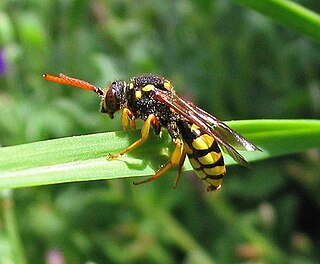
With over 850 species, the genus Nomada is one of the largest genera in the family Apidae, and the largest genus of cuckoo bees. Cuckoo bees are so named because they enter the nests of a host and lay eggs there, stealing resources that the host has already collected. The name "Nomada" is derived from the Greek word nomas, meaning "roaming" or "wandering."
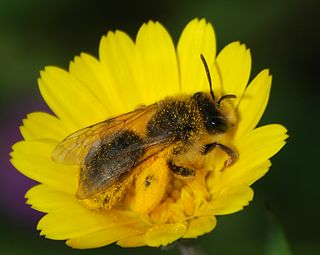
Andrena is a genus of bees in the family Andrenidae. With over 1,500 species, it is one of the largest genera of animals. It is a strongly monophyletic group that is difficult to split into more manageable divisions; currently, Andrena is organized into 104 subgenera. It is nearly worldwide in distribution, with the notable exceptions of Oceania and South America. Bees in this genus are commonly known as mining bees due to their ground-nesting lifestyle.
Andrena salicifloris, or the willow flower miner bee, is a miner bee in the genus Andrena. Another common name for this species is the willow mining bee. The bee ranges from Colorado to California and north to British Columbia, and often inhabits arid and alpine lands. The bee is often black or dark brown, and is sparsely coated with grayish hair on the thorax, legs and on the abdomen. The pollen basket is on most of the hind leg. The wings of the willow flower miner bee are smokey, and their veins are black.

Andrena hattorfiana is a species of mining bees belonging to the family Andrenidae subfamily Andreninae.

Andrena scotica, the chocolate mining bee or hawthorn bee, is a species of mining bee from the family Andrenidae. It occurs in western Europe and is one of the most frequently encountered mining bees found in Great Britain, where it had been previously misidentified as Andrena carantonica.
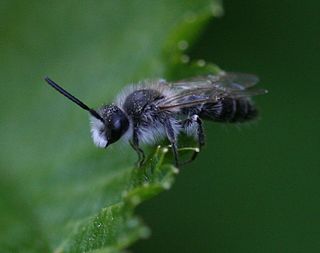
The bearded miner bee is a species of miner bee in the family Andrenidae. It is found in Europe and Northern Asia and North America. Other common names include the long-lipped andrena and the sandpit mining bee.
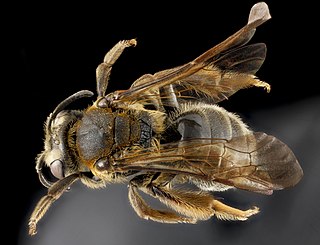
The Appalachian miner bee is a species of miner bee in the family Andrenidae. Another common name for this species is Alleghany andrena. It is found in North America. Its nests typically only have one or two cells. Adults overwinter in soil.

The two-spotted miner bee is a species of miner bee in the family Andrenidae. It is found in Central America and North America. Members of the species have communal nests made of many cells. They live in desert scrub habitat. Their primary host plants belong to the genus Helianthus.

Andrena prunorum, otherwise known as the purple miner bee, is a species of solitary bees in the family Andrenidae. It is commonly found in the continental United States as well as much of North and Central America. Andrena prunorum is a spring-flying, ground-nesting bee that serves as a ubiquitous generalist in ecological settings. Both males and females live as prepupae in the winter in which they mate, and the females seek new sites for ground burrows. From there, they construct small cells surrounding a ball of pollen combined with nectar to nourish a laid egg before each cell is sealed, and the cycle begins anew. A. prunorum generally prefer the pollen derived from Rosaceae plants but will pollinate fruit trees if given the opportunity.
The brown-tailed miner bee is a species of miner bee in the family Andrenidae. Another common name for this species the dark-tailed andrena. It is found in North America.

Andrena bicolor, or Gwynne's mining bee, is a common and widespread Western Palearctic mining bee which is found over most of Europe as well as North Africa and the Middle East and which reaches eastwards into Siberia.
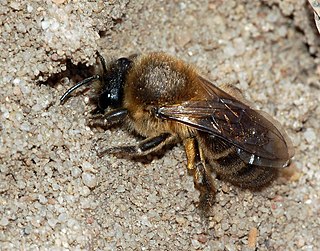
Colletes cunicularius, the vernal colletes or spring mining bee, is a species of solitary bee from the family Colletidae which is widespread in the Palearctic from Britain to the Pacific Ocean which nests in areas of open, sandy soil.

Hylaeus communis is a Palearctic species of solitary bee.

Osmia aurulenta is a Palearctic species of mason bee.

Camptopoeum friesei is a species of bees of the genus Camptopoeum.

Anthophora bimaculata is a species of bees.
Hoplitis mocsaryi is a species of bees in the genus Hoplitis.

Tetraloniella dentata is a species of bees within the genus Tetraloniella.

Trachusa byssina is a species of bees within the genus Trachusa.

Sichel's bumblebee is a species of bumblebee.


















